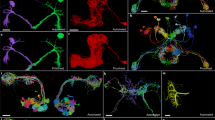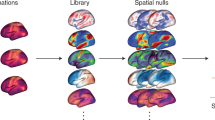Abstract
SNT is an end-to-end framework for neuronal morphometry and whole-brain connectomics that supports tracing, proof-editing, visualization, quantification and modeling of neuroanatomy. With an open architecture, a large user base, community-based documentation, support for complex imagery and several model organisms, SNT is a flexible resource for the broad neuroscience community. SNT is both a desktop application and multi-language scripting library, and it is available through the Fiji distribution of ImageJ.
This is a preview of subscription content, access via your institution
Access options
Access Nature and 54 other Nature Portfolio journals
Get Nature+, our best-value online-access subscription
$29.99 / 30 days
cancel any time
Subscribe to this journal
Receive 12 print issues and online access
$259.00 per year
only $21.58 per issue
Buy this article
- Purchase on Springer Link
- Instant access to full article PDF
Prices may be subject to local taxes which are calculated during checkout


Similar content being viewed by others
Data availability
The data required to generate the figures and analyses described in this manuscript are available at https://github.com/morphonets/SNTManuscript and https://doi.org/10.5281/zenodo.4568540.
Code availability
SNT source code is available at github.com/morphonets/SNT (ref. 18) under the GNU General Public License v3.0. Technical aspects of the software are described in Supplementary Note. The SNT application is available in Fiji by subscription to the ‘Neuroanatomy’ update site (https://imagej.net/SNT#Installation). User documentation, manuals and video-tutorials are available at https://imagej.net/SNT. https://github.com/morphonets/SNT (ref. 18).
References
Ascoli, G. A., Donohue, D. E. & Halavi, M. NeuroMorpho.Org: a central resource for neuronal morphologies. J. Neurosci. 27, 9247–9251 (2007).
Schindelin, J. et al. Fiji: an open-source platform for biological-image analysis. Nat. Methods 9, 676–682 (2012).
Schneider, C. A., Rasband, W. S. & Eliceiri, K. W. NIH Image to ImageJ: 25 years of image analysis. Nat. Methods 9, 671–675 (2012).
Longair, M. H., Baker, D. A. & Armstrong, J. D. Simple Neurite Tracer: open source software for reconstruction, visualization and analysis of neuronal processes. Bioinformatics 27, 2453–2454 (2011).
Günther, U. et al. Scenery: flexible virtual reality visualization on the Java VM. Preprint at https://arxiv.org/abs/1906.06726 (2019).
Chiang, A.-S. et al. Three-dimensional reconstruction of brain-wide wiring networks in Drosophila at single-cell resolution. Curr. Biol. 21, 1–11 (2011).
Heinze, S. et al. InsectBrainDatabase—a unified platform to manage, share, and archive morphological and functional data. Preprint at bioRxiv https://doi.org/10.1101/2020.11.30.397489 (2020).
Winnubst, J. et al. Reconstruction of 1,000 projection neurons reveals new cell types and organization of long-range connectivity in the mouse brain. Cell 179, 268–281.e13 (2019).
Milyaev, N. et al. The virtual fly brain browser and query interface. Bioinformatics 28, 411–415 (2012).
Rueden, C. T. et al. ImageJ2: ImageJ for the next generation of scientific image data. BMC Bioinformatics 18, 529 (2017).
Witvliet, D. et al. Connectomes across development reveal principles of brain maturation in C. elegans. Preprint at bioRxiv https://doi.org/10.1101/2020.04.30.066209 (2020).
Zubler, F. & Douglas, R. A framework for modeling the growth and development of neurons and networks. Front. Comput. Neurosci. 3, 25 (2009).
Cussat-Blanc, S., Harrington, K. & Pollack, J. Gene regulatory network evolution through augmenting topologies. IEEE Trans. Evol. Comput. 19, 823–837 (2015).
Scorcioni, R., Polavaram, S. & Ascoli, G. A. L-Measure: a web-accessible tool for the analysis, comparison and search of digital reconstructions of neuronal morphologies. Nat. Protoc. 3, 866–876 (2008).
Ferreira, T. A. et al. Neuronal morphometry directly from bitmap images. Nat. Methods 11, 982–984 (2014).
Bates, A. S. et al. The natverse, a versatile toolbox for combining and analysing neuroanatomical data. eLife 9, e53350 (2020).
Claudi, F., Tyson, A. L. & Branco, T. Brainrender: a python based software for visualisation of neuroanatomical and morphological data. Preprint at bioRxiv https://doi.org/10.1101/2020.02.23.961748 (2020).
Ferreira, T. et al. morphonets/SNT: SNT-3.1.114. Zenodo https://doi.org/10.5281/zenodo.4568604 (2021).
Withers, G. CIL:701, Rattus, multipolar neuron. CIL dataset https://doi.org/10.7295/W9CIL701 (2010).
Anderson, T. & Benson, D. CIL:810, Rattus, multipolar neuron. CIL dataset https://doi.org/10.7295/W9CIL810 (2010).
Wang, Q. et al. The allen mouse brain common coordinate framework: a 3D reference atlas. Cell 181, 936–953.e20 (2020).
Xu, S. et al. Behavioral state coding by molecularly defined paraventricular hypothalamic cell type ensembles. Science 370, eabb2494 (2020).
Feng, G. et al. Imaging neuronal subsets in transgenic mice expressing multiple spectral variants of GFP. Neuron 28, 41–51 (2000).
Asano, S. M. et al. Expansion microscopy: protocols for imaging proteins and RNA in cells and tissues. Curr. Protoc. Cell Biol. 80, e56 (2018).
Choi, H. M. T. et al. Third-generation in situ hybridization chain reaction: multiplexed, quantitative, sensitive, versatile, robust. Development https://doi.org/10.1242/dev.165753 (2018).
Legland, D., Arganda-Carreras, I. & Andrey, P. MorphoLibJ: integrated library and plugins for mathematical morphology with ImageJ. Bioinformatics 32, 3532–3534 (2016).
Ferreira, T., Hiner, M., Rueden, C., Miura, K. & Eglinger, J. IJ BAR, https://imagej.net/BAR. Zenodo (2017); https://doi.org/10.5281/zenodo.597784
Ollion, J., Cochennec, J., Loll, F., Escudé, C. & Boudier, T. TANGO: a generic tool for high-throughput 3D image analysis for studying nuclear organization. Bioinformatics 29, 1840–1841 (2013).
Ferreira, T., Arshadi, C. & Harrington, K. I. S. morphonets/SNTmanuscript 2.0. Zenodo https://doi.org/10.5281/zenodo.4568540 (2021).
Gillette, T. A., Brown, K. M. & Ascoli, G. A. The DIADEM metric: comparing multiple reconstructions of the same neuron. Neuroinformatics 9, 233–245 (2011).
Harrington, K. I. S., Ferreira, T. & Birgiolas, J. morphonets/cx3d: 0.0.4-SNAPSHOT. Zenodo https://doi.org/10.5281/zenodo.4568546 (2021).
Harrington, K. I. S. & scussatb. morphonets/grneat 0.0.5-SNAPSHOT. Zenodo https://doi.org/10.5281/zenodo.4568589 (2021).
Maaten, Lvander & Hinton, G. Visualizing data using t-SNE. J. Mach. Learn. Res. 9, 2579–2605 (2008).
McInnes, L., Healy, J. & Melville, J. UMAP: uniform manifold approximation and projection for dimension reduction. Preprint at https://arxiv.org/abs/1802.03426 (2018).
Acknowledgements
We are extremely thankful to J. Chandrashekar, A. Cardona and P. Tomancak for valuable input. We thank the community of users and contributors of Simple Neurite Tracer, the developers of SciJava, pyimagej and remaining open-source libraries required by SNT, and everyone who helped test the software. We thank W. Rasband, C. Rueden and the ImageJ community for developing and maintaining ImageJ and M. Rozsa and J. Baka for critical reading of the manuscript. We thank the reviewers for constructive feedback that improved SNT. Special thanks to all the laboratories, teams, institutions and initiatives that facilitate public sharing of neuronal data, including 3D InsectBrain, Allen Institute for Brain Science (including BigNeuron), Blue Brain, Cell Image Library, FishAtlas, FlyCircuit, FlyLight, InsectBrain Database, MouseLight, NeuroMorpho, OpenWorm and Virtual Fly Brain. This work was funded by the Howard Hughes Medical Institute. U.G. was funded by CASUS, which is financed by Germany’s Federal Ministry of Education and Research (BMBF) and by the Saxon Ministry for Science, Culture and Tourism with tax funds on the basis of the budget approved by the Saxon State Parliament.
Author information
Authors and Affiliations
Contributions
T.A.F. conceived and supervised the project. T.A.F. and C.A. wrote the core SNT. K.I.S.H. and U.G. implemented Cx3D/sciview integration. K.I.S.H. designed and ran simulations. M.E. performed the ExFISH experiment. T.A.F. analyzed the data. T.A.F. and K.I.S.H. wrote the paper.
Corresponding author
Ethics declarations
Competing interests
The authors declare no competing interests.
Additional information
Peer review information Nature Methods thanks Michael Hawrylycz, Stanley Heinze and Hermann Cuntz for their contribution to the peer review of this work. Nina Vogt was the primary editor on this article and managed its editorial process and peer review in collaboration with the rest of the editorial team.
Publisher’s note Springer Nature remains neutral with regard to jurisdictional claims in published maps and institutional affiliations.
Supplementary information
Supplementary Information
Supplementary Fig. 1, Note and Glossary.
Supplementary Video 1
Example of a programmatic animation: ‘Cumulative’ rendering of the complete MouseLight database in Reconstruction Viewer. The animation was generated on a laptop computer lacking a dedicated graphics processing unit using a single script that downloaded, measured and rendered each cell. See https://github.com/morphonets/SNTManuscript for details. Note that the number of cells in the database has meanwhile surpassed those rendered.
Supplementary Video 2
Showcase example of sciview capabilities, in which segmentation and volumetric data are rendered in the same scene. All data were loaded from the Cremi challenge (https://www.cremi.org) sample dataset ‘A’, with the ten largest volumes (by voxel count) shown in random colors. In addition, half the volume of the electron microscopy raw data is shown as a semi-transparent direct volume rendering.
Supplementary Video 3
Example of image-based modeling using Cx3D and a 3D volumetric image defining a microfluidic circuit designed to assess neurite outgrowth in response to Netrin-1 and Slit2. The simulation shows a single cell (magenta) with chemotaxis and branching preference for a steady-state chemical gradient (low concentration, purple and high concentration, yellow).
Rights and permissions
About this article
Cite this article
Arshadi, C., Günther, U., Eddison, M. et al. SNT: a unifying toolbox for quantification of neuronal anatomy. Nat Methods 18, 374–377 (2021). https://doi.org/10.1038/s41592-021-01105-7
Received:
Accepted:
Published:
Issue Date:
DOI: https://doi.org/10.1038/s41592-021-01105-7
This article is cited by
-
A presynaptic source drives differing levels of surround suppression in two mouse retinal ganglion cell types
Nature Communications (2024)
-
CAJAL enables analysis and integration of single-cell morphological data using metric geometry
Nature Communications (2023)
-
Circadian clock regulator Bmal1 gates axon regeneration via Tet3 epigenetics in mouse sensory neurons
Nature Communications (2023)
-
Norepinephrine regulates calcium signals and fate of oligodendrocyte precursor cells in the mouse cerebral cortex
Nature Communications (2023)
-
Online conversion of reconstructed neural morphologies into standardized SWC format
Nature Communications (2023)



